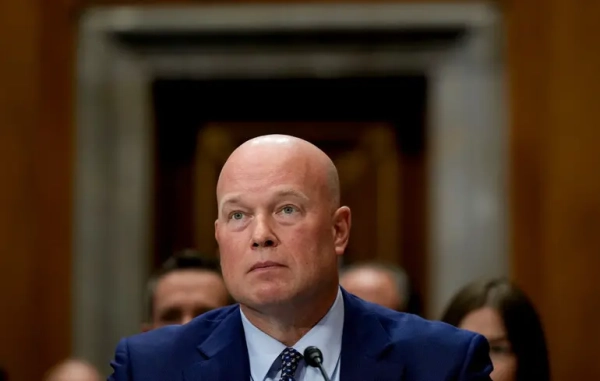The “unitary executive” is back, and it could supercharge Trump’s plans to fill the government with his own loyalists.

Former US President Donald Trump attends the UFC 295 event at Madison Square Garden on November 11, 2023, in New York City. Sarah Stier/Getty Images Ian Millhiser is a senior correspondent at Vox, where he focuses on the Supreme Court, the Constitution, and the decline of liberal democracy in the United States. He received a JD from Duke University and is the author of two books on the Supreme Court.
Last year, a federal appeals court dominated by Trump appointees and MAGA sympathizers ruled that the system the Securities and Exchange Commission (SEC) uses to protect investors from fraud is unconstitutional — and that it is unconstitutional in three ways. This case, known as SEC v. Jarkesy, will be heard by the Supreme Court on November 29.
To be clear, we are talking about a federal agency that has existed since the Roosevelt administration, and whose governing statutes haven’t changed in any relevant way for more than a dozen years. Nevertheless, an especially right-wing panel of the United States Court of Appeals for the Fifth Circuit purported to find three entirely different constitutional flaws that somehow no one else has ever noticed before.
The Fifth Circuit’s decision in Jarkesy isn’t particularly surprising. Indeed, it’s typical of a court that routinely hands down dubiously reasoned decisions that attempt to sabotage core functions of the federal government. We are less than two months into the Supreme Court’s current term, and it’s already heard two similar cases arising out of the Fifth Circuit — one of which declared a different agency, the Consumer Financial Protection Bureau, unconstitutional, and another which held that domestic abusers have a constitutional right to own a gun — neither of which the Supreme Court seems likely to affirm.
Jarkesy, however, could potentially end differently. None of the three rationales the Fifth Circuit offered for neutering the SEC are especially persuasive, but one of them is grounded in a pet project of the conservative Federalist Society known as the “unitary executive” — a project for which the current Court’s GOP-appointed majority has shown a great deal of sympathy.
There is a risk, in other words, that at least some of the Fifth Circuit’s effort to light this decades-old agency on fire could succeed, with implications that stretch far beyond securities fraud. A sweeping decision affirming the Fifth Circuit could potentially enable former President Donald Trump to stack the federal civil service with MAGA loyalists, should he become president again.
Under the strongest version of the unitary executive theory, there are few, if any, limits on a president’s power to fire government employees who refuse to swear personal loyalty to that president.
So what are the specific legal issues in Jarkesy?
The Jarkesy case is an attack on the federal government’s authority to use administrative law judges, a kind of highly specialized judge who hears cases brought by certain federal agencies. Administrative law judges are civil servants who are hired using a merit-based selection process. They are typically in-house at the agency where they hear cases, but they enjoy robust job security protections to ensure that their decisions are impartial.
In total, the federal government employs about 2,000 of these judges — more than twice as many as the federal district and circuit court judges serving on what’s known as “Article III” courts. Most of the administrative law judges hear cases about whether impoverished Americans are entitled to federal benefits, but some hear enforcement actions brought by agencies like the SEC.
Article III judges generally hear all kinds of cases rather than focusing on one narrow subject matter. And Article III judges are political appointees who must be nominated by the president and confirmed by the Senate, unlike administrative law judges, who are civil servants appointed through a merit selection process.
The Jarkesy case involves George Jarkesy, a hedge fund manager who, according to the government, committed multiple violations of federal securities law. DOJ’s brief says that Jarkesy and his company told investors that the hedge funds were audited by a prominent accounting firm, “even though the firm never audited the funds.” The funds also allegedly misrepresented their investment strategies. And they were accused of “arbitrarily inflating the value of certain holdings from $0.30 per share to $3.30 per share — so that they could charge higher management fees.”
Eventually, the SEC brought an enforcement action before an administrative law judge, who determined that Jarkesy violated federal securities law. The SEC eventually ordered Jarkesy and his funds to pay a civil penalty of $300,000, and to “disgorge nearly $685,000 in illicit gains.”
Jarkesy raises three separate constitutional objections to this proceeding in the Supreme Court, all of which were embraced by the Fifth Circuit. All of them fault the government for bringing its enforcement action before an administrative law judge, instead of filing a lawsuit against Jarkesy in an Article III court. (An administrative law judge’s decision ordinarily can be appealed to a federal circuit court, which is made up of Article III judges, so the law does not permit the SEC to avoid Article III courts altogether.)
Federal law permits the SEC to choose whether to bring certain enforcement actions either in a federal district court (one presided over by an Article III judge) or before an administrative law judge. And, at the outset, it’s important to note that laws permitting litigants to choose which venue they bring a lawsuit in are quite common.
Many routine disputes between private litigants may be brought in either state or federal court, for example. Some tax disputes between individual taxpayers and the federal government may be brought in either an ordinary district court, a more specialized court known as the US Court of Federal Claims, or in the US Tax Court — a court made up of judges who focus on tax law. If the Justice Department wishes to bring criminal charges against someone who committed crimes across the Texas-New Mexico border, they might choose to bring those charges in a New Mexico federal court, because New Mexico is located in the 10th Circuit, while the same case brought in Texas would appeal to the chaotic Fifth Circuit.
Nevertheless, the first of Jarkesy’s objections to the SEC’s proceeding against him is that the law permitting the SEC to choose which venue to bring enforcement actions in is itself unconstitutional under a largely defunct doctrine known as “nondelegation,” which supposedly limits Congress’s ability to delegate decision-making power to federal agencies.
This is far and away the weakest of Jarkesy’s three arguments. The Supreme Court has only struck down two laws in all of US history for violating the so-called nondelegation doctrine, and it hasn’t done so since 1935. Federal law enforcement agencies routinely make decisions that are far more consequential for criminal and civil defendants than choosing which venue will hear a particular case.
In United States v. Batchelder (1979), for example, Congress enacted two firearms statutes that each authorized “different maximum penalties,” and effectively let prosecutors choose which statute to invoke when a criminal defendant’s conduct violated both of them. But the Supreme Court upheld this scheme, concluding that “the power that Congress has delegated to [federal prosecutors] is no broader than the authority they routinely exercise.”
If the Constitution permits law enforcement agencies to make decisions as significant as whether to charge a criminal defendant under a statute that carries a maximum penalty of five years in prison, or to instead charge them under a statute that only authorizes a two-year sentence, then it permits such agencies to make far less consequential choices, such as choosing the venue for a civil enforcement proceeding.
Jarkesy’s second argument is that bringing his case before an ALJ violates the Seventh Amendment, which provides that “in suits at common law … the right of trial by jury shall be preserved.”
Although criminal defendants have an absolute right to a jury trial, the rules governing civil suits, such as SEC enforcement actions, are more complicated. Article III courts sometimes try civil cases before a jury, but administrative law judges typically do not: One of their primary advantages is that they are typically experts on the kinds of cases that come before them. Using a jury to conduct fact-finding would negate this advantage, as jurors rarely know very much about subjects like securities fraud.
The Seventh Amendment lays out when juries are required in civil suits: only “in suits at common law.”
The “common law” refers to a body of judge-created law that developed over many centuries in English courts, and that was passed down to American courts during the colonial period. This common law is often distinct from statutory law, laws created by Acts of Congress or a state legislature. Thus, in Atlas Roofing v. OSHA (1977), the Supreme Court held that many suits brought under a federal statute may be heard by an administrative law judge in a non-jury proceeding.
And that brings us to Jarkesy’s third argument, the claim that the SEC action against him violates the theory of the “unitary executive.”
The unitary executive, briefly explained
The basic concept underlying the theory of the unitary executive is that the president of the United States must have command and control over the entire executive branch of the federal government. In practice, this means that the president must either be able to fire every single federal employee, or they at least must have the power to fire every federal employee’s boss.
The theory derives from a provision of the Constitution that states that “the executive power shall be vested in a President of the United States of America.” As Justice Antonin Scalia described the unitary executive theory in a 1988 dissenting opinion that is now treated as if it were a holy text by many members of the Federalist Society, this constitutional provision “does not mean some of the executive power, but all of the executive power” must be vested in the president.
Taken to its logical extreme, this theory would eliminate the federal government’s ability to maintain a professional civil service made up of officials who are protected against being fired for purely political reasons. Under the strongest version of the unitary executive theory, every single federal employee, down to individual postal workers, must be accountable to the president — although even Scalia did not seem to go that far, instead suggesting that the unitary executive theory may be limited to “officers of the United States,” relatively high-ranking government officials who typically have some amount of discretionary authority.
If the Court were to implement a strong version of this theory, that would obviously be a tremendous boon to Donald Trump, who has already announced plans to replace thousands of nonpartisan civil servants with MAGA loyalists if he becomes president again.
There are weaker versions of the unitary executive theory that wouldn’t allow the president to fire every FBI agent who refuses to swear personal fealty. But even these weaker versions could potentially give presidents power to manipulate elections, and to interfere with technocratic aspects of government that historically have been removed from partisan politics, such as the Federal Reserve.
Administrative law judges are civil servants who may only be removed “for good cause,” and any removal decision may be reviewed and potentially overturned by the Merit Systems Protection Board, a government panel whose members also enjoy some protections against being fired. Jarkesy claims that this arrangement violates the Supreme Court’s decision in Free Enterprise Fund v. Public Company Accounting Oversight Board (2010), which held that the members of a government board that oversees accounting firms enjoyed too many safeguards against being fired — in violation of the unitary executive theory.
There are some superficial similarities between the “good cause” job security offered to administrative law judges and the job security provision that was struck down in Free Enterprise Fund, but the Supreme Court’s decision in that case also acknowledged that these judges may be categorically different from other government officials.
Most notably, the accounting oversight board members at issue in Free Enterprise Fund were policymaking officials, with the power to set “auditing and ethics standards” for the accounting industry. Administrative law judges, by contrast, “perform adjudicative rather than enforcement or policymaking functions” — that is, they apply a preexisting policy to individual cases, rather than setting the policy themselves.
This distinction matters because one of the leading arguments for the unitary executive theory is that it fosters democracy, by ensuring that policymaking decisions are made by officials who are accountable to an elected president. But this argument is much weaker when applied to non-policymaking officials.
There’s also something fundamentally incoherent about Jarkesy arguing that his trial before an administrative law judge was unlawful because that judge is insufficiently accountable to the president. After all, the alternative to a proceeding before an administrative law judge is a trial before an Article III judge. And Article III judges serve for life and are completely unaccountable to the president.
Nevertheless, the Supreme Court’s current, Republican-appointed majority has shown enough sympathy for the unitary executive theory that there is, at least, some risk that five or more justices will side with Jarkesy on this issue.
This case is potentially a moment of truth for the Supreme Court
Several members of the current Court are evangelists for the unitary executive theory. When future Justice Brett Kavanaugh was asked, in 2016, to name a Supreme Court case that he would like to overrule, for example, he said he wants to “put the final nail in” Morrison v. Olson’s coffin — Morrison was the 1988 case where Scalia wrote his dissent laying out the unitary executive theory.
Thus far, however, the Supreme Court has largely made only symbolic moves toward the stronger versions of this theory. The Court has not, at least not yet, questioned the independence of the federal reserve. It has not come for civil service protections for nonpartisan government employees. And the few victories it’s handed down to proponents of the unitary executive theory have made only marginal changes to the structure of the federal government.
Free Enterprise Fund, for example, stripped some job security protections from the members of a specific accounting oversight board, but those members had an unusually high degree of insulation from being fired. And the Free Enterprise decision includes several caveats limiting its scope, including the language suggesting that it should not be applied to ALJs.
Similarly, in Seila Law v. CFPB (2020), the Supreme Court held that federal agencies may not be led by a single director who can only be fired by the president for cause. But Seila Law left open the possibility that agencies (like the Federal Reserve) may be led by multi-member boards who enjoy some protections against being fired by the president.
If the Court comes for ALJs in the Jarkesy case, however, that will be far more than a symbolic step toward the unitary executive theory. Again, there are nearly 2,000 ALJs in the federal system, more than twice the number of Article III judges. So a decision striking down these ALJs would destroy much of the government’s ability to adjudicate cases. And a decision stripping these ALJs of their civil service protections could transform a huge array of legal proceedings, which are supposed to be heard by objective and nonpartisan officials, into politically driven proceedings.
And, of course, looming over all of this is Trump, with his plan to replace much of the civil service with people personally loyal to him. In the worst-case scenario for liberal democracy, the Supreme Court could use the Jarkesy case to greenlight many of Trump’s most authoritarian aspirations.
Sourse: vox.com






